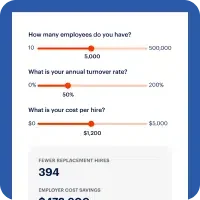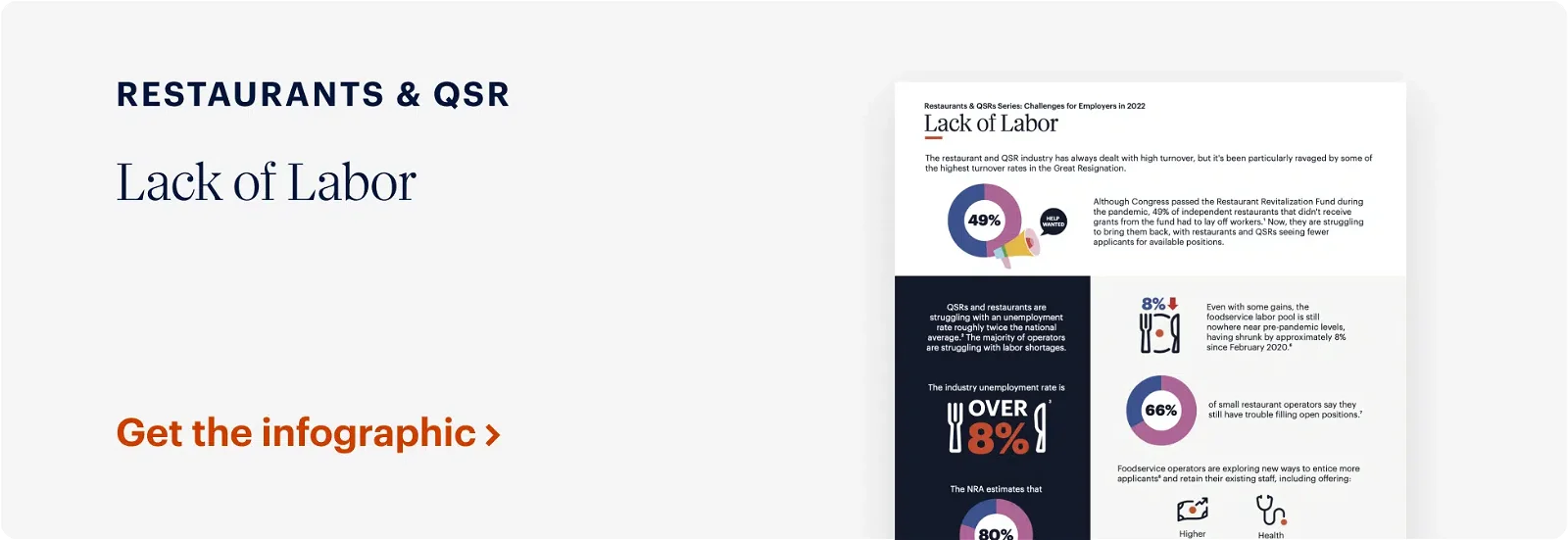How Restaurants and QSRs Can Motivate Their Employees to Return to Work and Improve Diners’ Experiences
More in this Series
Rebuild Broken Trust With Employees in the Restaurant and QSR Industries
Many restaurant and Quick Service Restaurant (QSR) managers were forced to lay off portions of their staff during the pandemic. In addition to layoffs, some employees chose to quit their former roles due to the increased pressure from being understaffed and the resulting burnout. 78% of restaurant owners say they currently do not have enough staff to properly run their business.¹ According to the National Restaurant Association, the industry is still 1 million jobs short of pre-pandemic levels.² In June 2021, turnover rates are were at 144% for QSRs and 106% for full-service restaurants,² and in November 2021, 1 million restaurant and hotel employees left their jobs.³
Effective restaurant and QSR managers are hard at work to uncover the root causes of their companies’ staffing issues so they can find solutions to win back their employees’ trust. The first step to creating positive change is understanding what employees need right now to repair the current rifts and incite positive forward motion. By improving their staffing, it’s hopeful that restaurants and QSRs will also be able to improve their customer experience by having more workers to meet their needs. If restaurants and QSRs can build back an engaged, committed workforce, they will be better equipped to deliver on diner expectations.
Foodservice Employees Feel Expendable and Deprioritized
Some restaurant and and QSR employees felt a sense of distrust during the pandemic, both due to layoffs and unsafe working conditions.⁴ “My boss has wanted things to get back to ‘normal’ immediately and started indoor dining the day it could come back, and lowered restrictions as soon as he could without asking the staff how they felt,” a former restaurant employee told Food and Wine.⁴ “The amount of complaints and overall disrespect that some people treated us with, when we were risking our safety and doing everything right for them while they chose to eat out, really shocked me.”
Not only did some employees feel physically unsafe and potentially exposed to illness, they also lost trust in the employers they felt weren’t putting their safety and well-being above the restaurants’ financial recovery.⁴ These may be some of the major reasons why 38% of former employees are choosing to work in other industries.⁴ This disengagement may have contributed to the 21% reduction in restaurant staffing.¹
Lack of Workers is Impacting the Guest Experience
Having fewer employees on staff means fewer workers will be available to serve customer needs, which will negatively affect the guest experience. One restaurant owner cited that diners will come into his restaurant and want to sit at empty tables, but he doesn’t have the staff on hand to serve those sections.¹ Instances like this are understandably confusing and frustrating for customers whose expectations aren’t being met. This may negatively impact repeat business by discouraging those customers from returning.
Rebuild Trust and Bring Back Workers with a Focus on Employee Wellness
Restaurant and QSR managers are looking for resources to help rebuild a sense of community and camaraderie within their business. Employers can consider new ways to showcase sustainable career opportunities for their employees with room for growth. They can also foster healthy work environments by following increased safety protocols and making sure employees feel that their concerns are heard. Studies have shown that improving the employee experience is directly correlated with positive improvements in customer experience as well, as happier employees are more motivated to excel in their roles.⁵
Technology can be extremely helpful in improving the employee experience, which also ultimately improves the diner experience. According to a recent study, using restaurant technology can help reduce employee turnover by 13%.² For instance, utilizing online applications can help grow the applicant pool, making it easier for restaurant owners to find highly-qualified candidates.
Adding benefits such as tuition reimbursement, sign-on bonuses or on-demand pay to your total rewards package can also help employees feel valued. These employee-focused benefits can make staff feel more valued, helping to re-establish trust in the employer-employee relationship. After implementing on-demand pay, a DailyPay client in the QSR industry reported a 72% reduction in employee turnover.⁶ By giving employees flexibility in their pay schedules, businesses are empowering their staff to access their earned pay as they need it, helping them pay bills on time, put money into savings and save an average of $1,205 per year in late fees, overdraft fees and payday loan fees.⁷
Want to learn more about how adding an on-demand pay benefit can help encourage your employees to return to work?
1 https://spectrumlocalnews.com/nys/capital-region/news/2021/11/24/labor-shortage-weighs-heavy-on-restaurant-industry-during-holidays:DailyPay, 2020
2 https://www.restaurantdive.com/news/why-arent-restaurant-workers-coming-back-heres-what-the-data-shows/606198/:DailyPay, 2020
3 https://www.businessinsider.com/restaurant-worker-shortage-continuing-through-2022-survey-2022-2:DailyPay, 2020
4 https://www.foodandwine.com/fwpro/real-reason-restaurant-worker-shortage:DailyPay, 2020
5 https://hbr.org/2019/08/the-key-to-happy-customers-happy-employees:DailyPay, 2020
6 https://www.dailypay.com/resource-center/blog/how-qsr-restaurant-captain-ds-reduced-employee-turnover-dailypay/:DailyPay, 2020
7 https://www.dailypay.com/insights/our-survey-says-dailypay-saves-employees/:DailyPay, 2020
More for QSR & Restaurants
Learn how on-demand pay may address top challenges across the industry.















